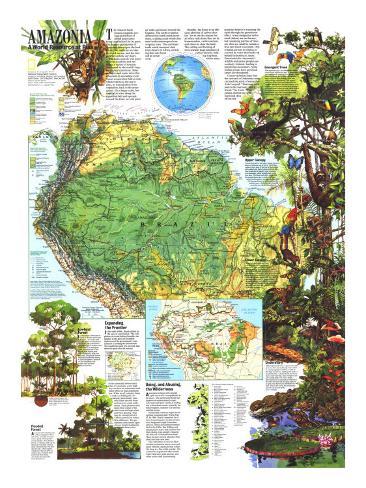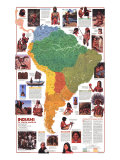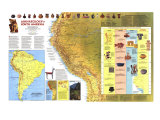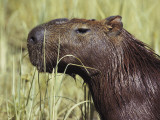The 1992 “Amazonia, A World Resource At Risk” map features:
• A physical and political map of the Amazon basin
• Information on the Amazonian ecosystem and the various ways its health affects the overall health of the planet
• Inset showing the atmospheric circulation of winds
• Selected industry and land use within the Amazon basin
• Illustrations of the flora and fauna of the Amazon rainforests
• Transportation and additional sites of importance
• Information on the threats facing this region of the world
* Lesson plan idea - have your students update the information and latest statistics concerning Amazonia and the world environmental crisis; discuss, contrast and compare the contributing and resulting political and economic situations. • maps
AMAZONIA - A World Resource at Risk
Tha Amazon basin houses a gigantic ecological machine of global importance being cannibalized for its parts. The human exploitation of Amazonia bears upon the food we eat, the medicine we take, the wood we use, and the temperature outside our door.
The basin sprawls over parts of seven South American countries (Bolivia, Brazil, Colombia, Ecuador, Guyana, Peru, and Venezuela) and embraces a variety of terrains dominated by the world's largest tropical rain forest. Solar radiation and water drive this ecosystem in an endless cycle: Ocean evaporation falls as rain, which returns to the sea or rises, by transpiration from vegetation, back to the atmosphere. On a larger scale, hot tropical air rises along the equatorial belt and spreads toward the Poles, as cold polar air sinks and moves toward the Equator. The Earth's rotation deflects this north-south movement, creating trade winds that meet in the intertropical convergence zone. The northeast trade winds transport dust from deserts in Africa, enriching thin rain forest soil an ocean away.
Healthy, the forest is an efficient absorber of carbon dioxide. Yet in the dry season the air often reeks from fires set by homesteaders, cattle ranchers, and others to clear the land. The cutting and brning of trees releases huge amounts of carbon dioxide, helping trap heat, whch many scientists believe is warming the Earth through the greenhouse effect. Areas designated deforested are not barren, but remaining patches of trees are often too small to sustain a true rain forest ecosystem. Other lands are lost to mining or covered by water that backs up behind hydroelectric dams. Sanctuaries for Amazonia's wildlife and native peoples are routinely violated, leading to murderous encounters. Some Indian groups have perished; others are threatened.
Conservationists hope that the stewards of Amazonia my yet heed the spirit of naturalist aldo Leopole: “Harmony with land is like harmony with a friend,” he wrote. “You cannot cherish his right hand and chop off his left.”
Expanding the Frontier
In the early 1960s, Brazil picked up the pace of colonization. The completion of a road linking Brasilia, the capital, to the port city of Belem underscored the government's commitment to settling the hinterlands. The road forms part of a network that abets the push into the interior.
In the essentially lawless out reaches of Amazonia, a new highway can have an unintended multiplier effect on local population size. When an oil company clears a road to a drilling site, for example, land-hungry peasants follow the new route and hackout crude settlements. These pioneers then ignite their corner of the rain forest and begin slash-and-burn farming. That they do virtually all of it without permission makes little difference. The government enforcement agencies are simply inadequate to stop the destruction.
Using, and Abusing, the Wilderness
Amazonia beckons with enough gold ore to stir a conquistador in his grave. The Earth hold fossil fuel deposits of undetermined extent. Above ground grow stands of mahogany whose dense wood, prized by furniture makers, matures to a lustrous reddish brown.
Amazonia countries began development in earnest after World War II. In 1966, Brazil channeled its efforts toward massive swaths of territory designated Legal Amazonia, where development intensified in the 1980s. But drilling and mining leave scars, and farmers find that raising crops quickly exhausts the thin soil of cleared forest land. Many farmers merely abandon their plots and clear new ones.
The cultivation of coca for illicit cocaine production leaves rivers polluted with the chemicals that render the drug as a fine white powder. The extraction of gold and other metals fouls waterways with mercury and other toxins used in processing.
Lowland Forest - In Amazonia's cornucopia as many as 283 tree species can be found in a two-and-a-half-acre plot. Dense lowland forest, terra firme, the predominant type in the region, includes such timber sources as mahogany, cedar, and Brazil nut. Compunds from tropical flora relieve headaches, help treat glaucoma, and provide muscle relaxants used during surgery. As forest disappears, researcher fear that plants with wonder-drug potential will be lost forever.
Flooded Forest - Amazonia is drenched by rainfall averaging from 80 to 120 inches annually. some forests are partly submerged for several month. These flooded forests, or varzeas, make up less than 2 percent of the Amazon basin's forested land. But their alluvial soils, which support wild grasses that can grow six inches a day, are much more fertile than those being cleared for farming in the terra firme forest.
Understory - Sliterhing from the river, a green anaconda goes on a slow search for prey. Even a deer or a young capybara could be a victim of this huge constrictor. A fishing bat makes a nocturnal strike. A jacana hunts for insects atop a royal water lily, large enough to support a small child. The word “jungle,” often misused as a synonym for rain forest, describes the lush wall of foliage adjacent to open areas that receive abundant sunlight. Deep in the forest, the ground may get only one percent of the area's sunlight.
Lower Canopy - A kind of way station, the lower canopy is used by many animals en route to more permanent haunts atop the trees or on the ground. A scarlet macaw looks for nuts to crack. Father below, a tarantual searches for a meal of katydids and locusts. A common iguana, which feeds on fruit and succulent leaves, lolls on a branch. Moving farther down, it elues predators by dropping into the river. That's no assurance of safety from a jaguar, which–though it can climb most any tree–usually hunts in or near the water.
Upper Canopy - Viewed from above, the upper canopy forms an almost continuous sea of green. This foliage captures more than 90 percent of the sunlight and conducts the bulk of photosynthesis, the food prouction of plants. Some creatures, even mammals, spend virtually their entire lives here. The three-toes sloth, which visit the ground about once a week to defecate, moves in slow motion, its young holding fast. On the same branch a red-handed howler monkey roars, while a morpho butterfly treats the eye with startling blue.
Emergent Trees - With imperious gaze, an endangered Guiana crested eagle searches for prey. A harpy eagle, also endangered, homes in for a landing. Rain forest destruction has spelled extinction for many creatures whoe habitats have been reduced below critical levels. The raptors' perch wins in the incessant competition for sunlight. Poking above the dense canopy of its neighbors, the tree gets a boost in its propagation when winds scatter its seeds. Birds such as the lemon-throated barbet and the channel-billed toucan help other trees by dispersing seeds in their droppings as they fly.



















